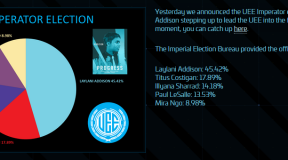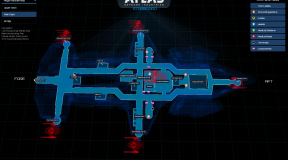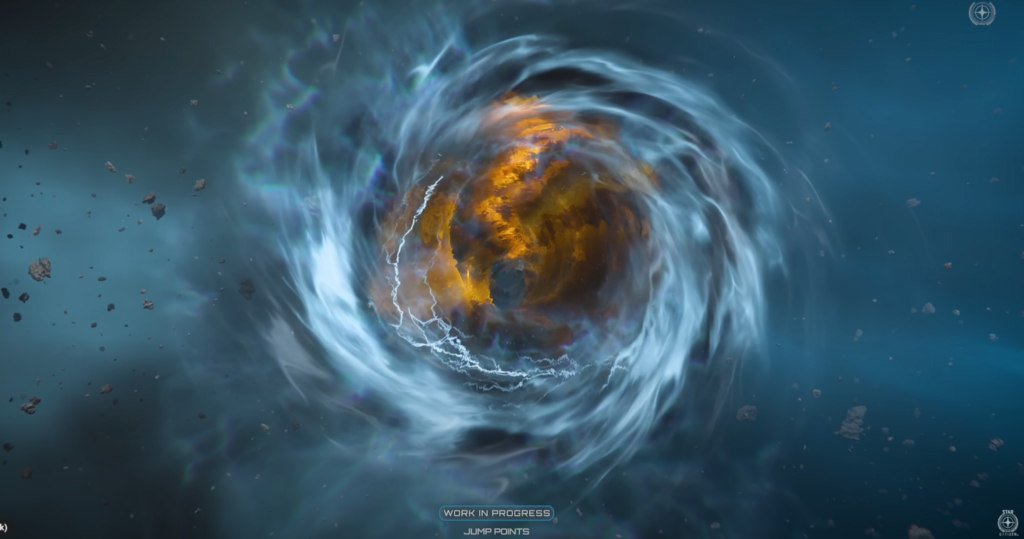
A staple of sci-fi is travel. Since sci-fi itself is exploratory, a lot of sci-fi stories feature new and innovative ways to get from point A to point B, usually in service of exploration. How characters travel isn’t as varied as you’d think, though, considering how speculative sci-fi is meant to be. There’s teleportation, faster than light drives, old-fashioned sub-light travel, and on rare occasions, transfer of consciousness either ephemeral, physical, or digital. These examples have one thing in common, though: they all require human invention to achieve. There’s only one frequent flyer that fiction likes to lean on that could be naturally occurring, and that’s the wormhole.
Star Citizen’s current gameplay (as of mid-2024) features FTL travel in the form of “quantum jumps”. These allow players to get from one side of a solar system to the other over time but also at this point in the game’s development, there’s only one system, Stanton, so other, faster modes haven’t really been useful or needed. CIG hopes to get a second system, Pyro, out into the wild by the end of 2024 and will connect it with Stanton by their version of the wormhole which they are calling “jump points”
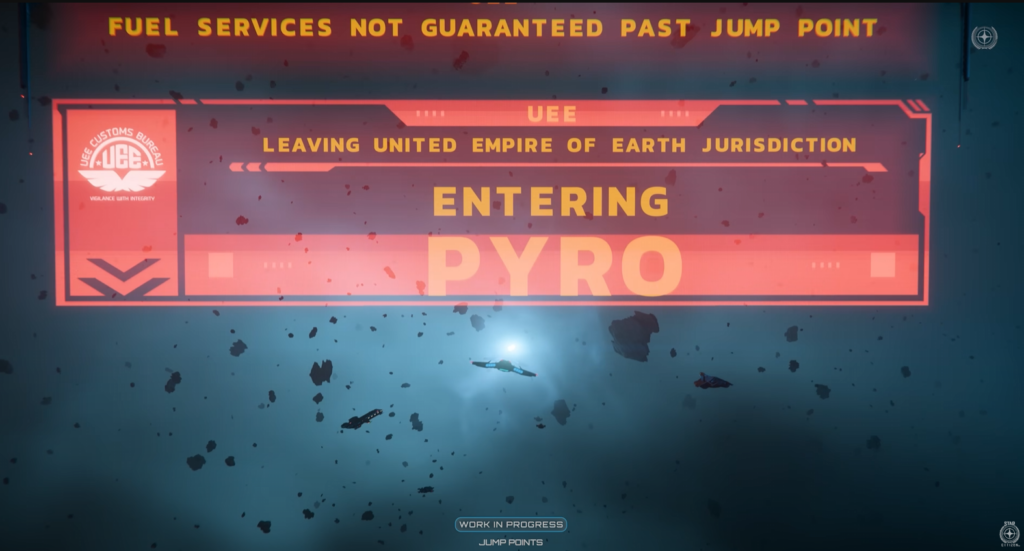
This is a massive, massive milestone for Star Citizen in many ways. The most obvious is that it’s part of the 4.0 patch which brings another star system into the game. That also means that other star systems have the technological green light to get into the game as well once players have an in-game road to travel between systems. Jump points will also be the gateway (pun not intended) to the long-awaited server meshing which should allow far more players-per-server than we’ve experienced in the past.
What is a jump point?
In the Star Citizen lore, jump points were discovered — unfortunately — by accident when a cargo vessel suddenly vanished from it’s route. Years later, explorer Nick Croshaw experienced a leak in his quantum drive along the same route, and this unique circumstance helped identify the wormhole that lead to a new solar system. Once they knew what to look for and how to find it, humanity started looking for other jump points.
Original concepts for jump points in Star Citizen leaned heavily into the sci-fi trope of a construct through which ships would fly in order to use the conduit. In a recent episode of Inside Star Citizen, it was noted that since the lore indicated that jump points were both naturally occurring and stable, adding the “ring” around the entrance and exit didn’t make sense. In many sci-fi stories which also feature these gate structures, they are used to keep wormholes open, or to create them at will. The initial gate design was also purported to control the size of the ships that could pass through, but with their removal, now any ship of any size can use the known jump points.
ISC also mentioned the concept of “transient jump points”. These are previously unknown (or unknown to you) jump points whose destinations are as of yet unknown. They are unmarked and potentially exist in out of the way places in a system. These will limit the size of the ships that can enter and may come and go in both place and time. Undiscovered jump points play into the exploration game which should allow players to scan, find, use, and even sell coordinates for these rogue wormholes. They’re also going to be useful for players and organizations who wish to avoid scrutiny by authorities at the main, persistent jump points.
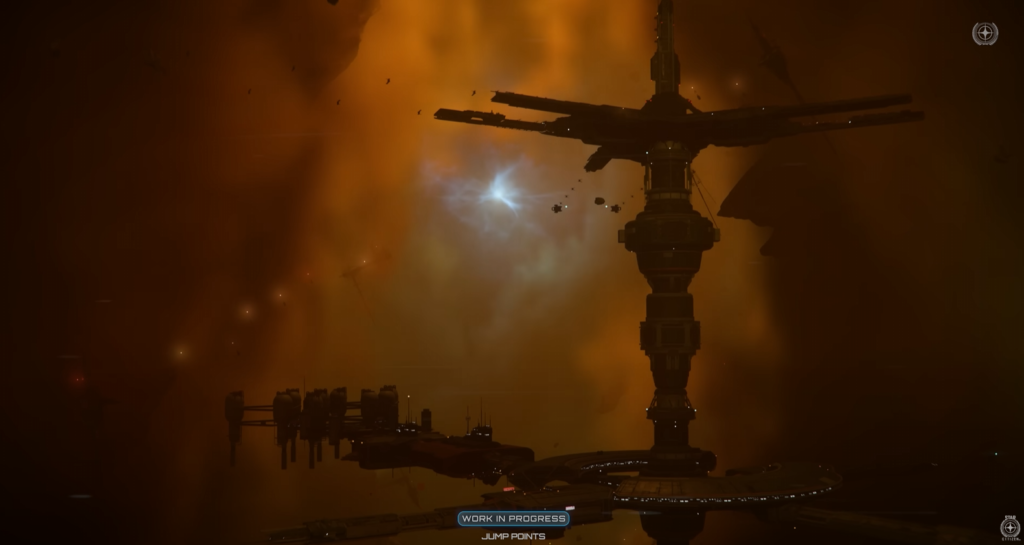
Anatomy of a Jump Point
The developers walked us through how jump points are planned to work in an ISC video.
The first step is to head over to a known, marked jump point. These will be available on the star map and can be navigated to through quantum travel.
Once there, you’ll encounter the “border infrastructure”.
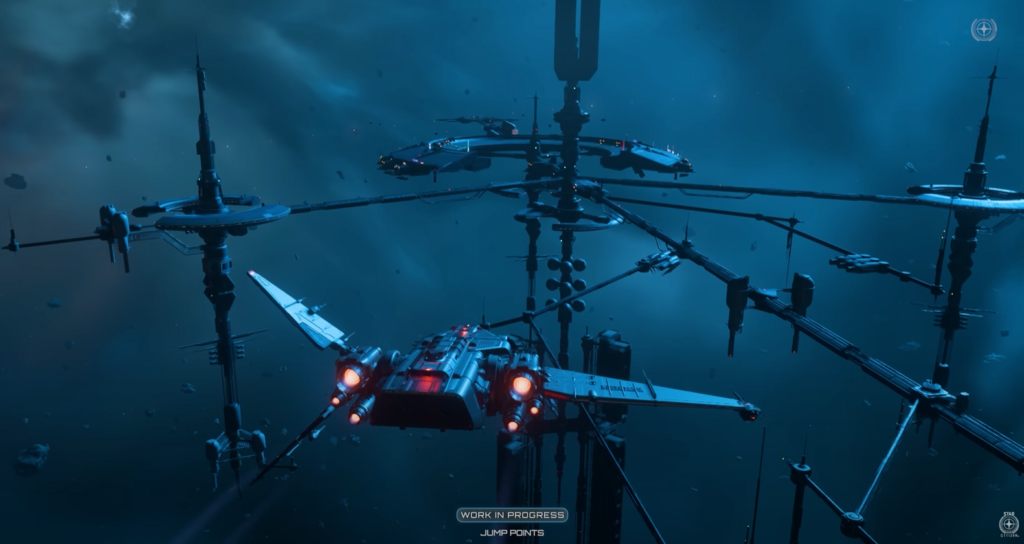
These are stations which will offer players the kinds of amenities that we might expect (or hope for) when traveling between two points: refuel, repair, and refit services, food, water, armor, weapons, ammo, and other things that players can stock up on before moving to the mouth of the wormhole.
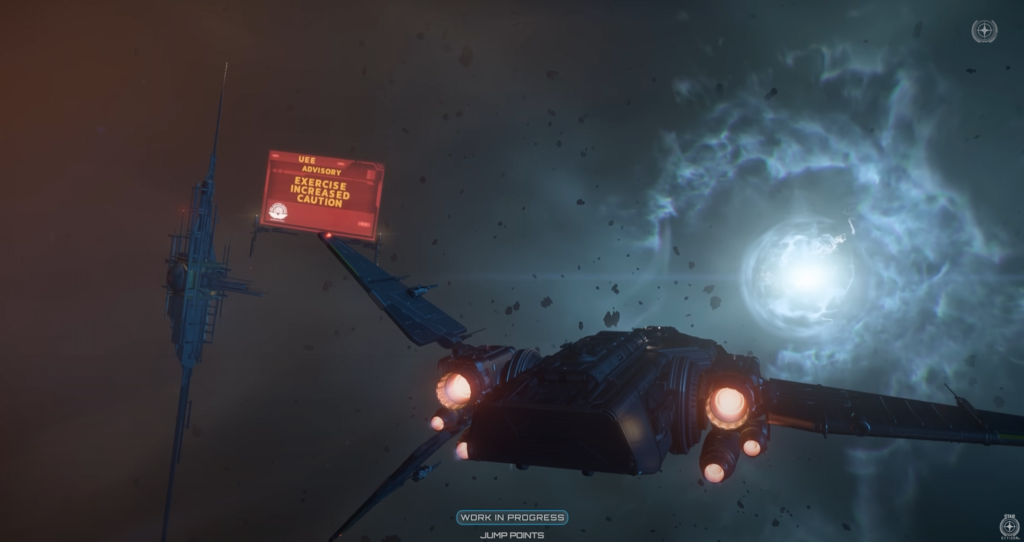
Even without the gate constructs, the entrance to the jump point will be visible and obvious. As players approach, the wormholes have their own ominous, thunderous audio cues as well to sell the idea that these maelstroms are naturally occurring and potentially dangerous.
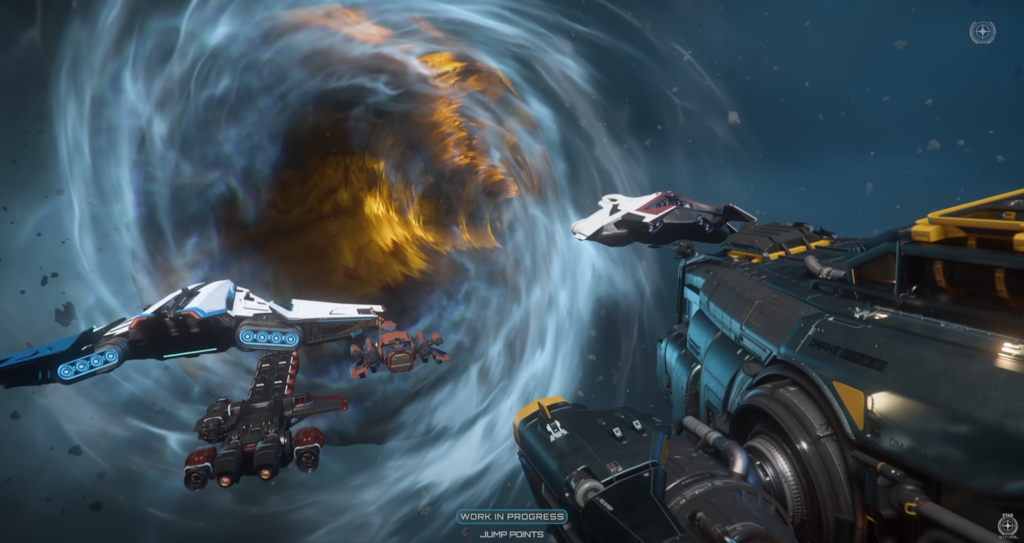
Multiple ships can travel through the jump point at once, but access to the portal is controlled by the ATC (“air” traffic control) operators working out of the local station. Everyone who approaches the jump point needs to make their own request, but the ATC will “group” players and grant them access together. Unfortunately at this time players in a group are not guaranteed to be in the same group; the only way to get into a group with friends or org-mates is to try to make a request at the same time, and either accept the assignment or opt to wait for the next group. They are working on pre-made group groups, though, but it won’t be available in 4.0.
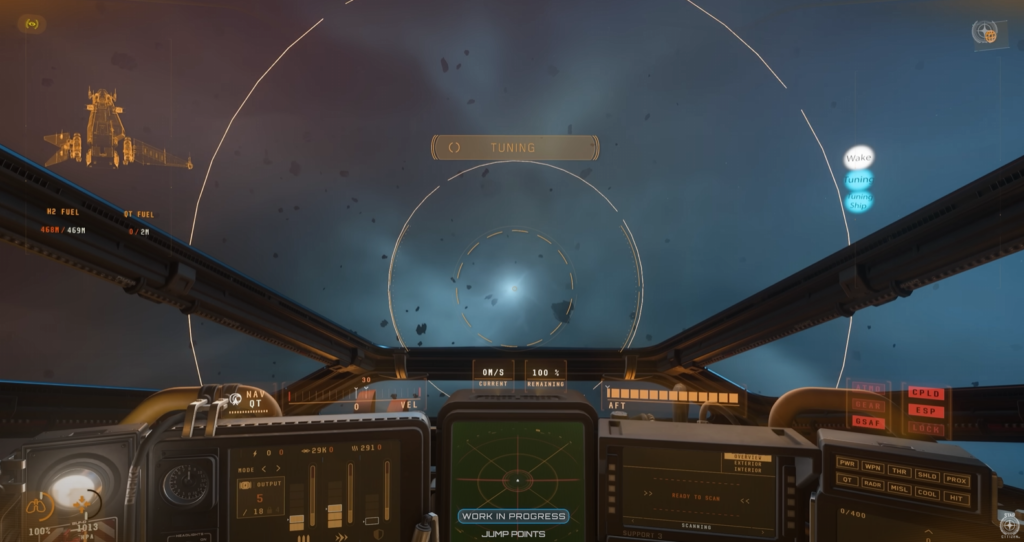
Ships need to “attune” to the jump point before they can enter. Maintaining alignment with the resulting attunement path on the HUD will be required; moving off-center will break the attunement, and anything that gets in between you and the jump point will also break the attunement. As stated in the video, this could be a hot-button topic for griefing, but the jump point has a natural repelling force that, if a ship is not part of an attuned group, it will be forcibly removed from the path of the jump point. CIG is continuing to look into and accept feedback on ways to ensure people can travel uninterrupted. Un-attuning will forfeit your position in the queue, requiring you to contact ATC for another group slot.
When you have been approved, your ship will activate the wormhole and your group will be automatically pulled through the entrance.

Now that you are in the wormhole, you will be flying at a set speed set by the tunnel. While you can’t speed up or slow down, you will have to navigate your ship around corners while sticking to the rough center of the conduit. Your group members will be ahead and behind, single file, and traffic is one way; the devs say that this is to keep things simple and to avoid potential collisions — accidental or intentional. If you lose control and breach the tunnel wall, you are dropped off…somewhere between your start and end point, but not in a way that’s targetable.
Thoughts
As stated earlier, the addition of jump points to the game heralds the larger addition of server meshing and the addition of the Pyro star system. It’s always been my hope that while CIG has been working on a lot of high-profile features mentioned to the public, other parts of the company have been using their time to create other star systems. I know that CIG’s “pattern” has been to talk about points of interest in Stanton, and also in Pyro, but that really shouldn’t have to happen with every single star system. I also know gamers and once a pattern emerges it’s ride or die, so point-by-point dossiers would be expected by a segment of the community. Still, being told that a new system — or a few at a time — have been added to the game at some point (obviously no time soon), would be opening a frontier to players to find, explore, and exploit those new places. Once we have jump points settled at least to the point where they are usable, and server meshing works out at least as well as devs have been saying it has (at least on camera), my wish list bingo card has “more systems” on it.
Unfortunately, it seems that CIG’s decision to nix the gates (SC pun there) has stirred up some strong feelings on Spectrum. A lot of people seem to really be offended by the lack of a formal structure denoting the presence of the jump point. So far the three prevailing arguments I’ve seen have been that A) it could control access instead of or act as a better focal point for ATC, B) it would assume to be there to “stabilize” the wormhole, and C) it looks “badass”.
I can see where folks are coming from with “A” because the current system assumes that the UEE (or other system owners) have a means of reaching out over a distance to disable a ship’s jump drive. In lore terms, that might be a manufacturing requirement, but who’s to say that pirates wouldn’t just…disable that? I would expect that they would, making their ship ungovernable. And if ATC is the only reason why ships can’t just attune and go, then ditching that for an “aperture” or some sort in the form of a ring could make more sense. But then again, someone on Spectrum mentioned that lawless or abandoned systems would not have the resources to build, nor maintain, a gate structure, and if gate structures are needed to operate the jump point then no one could leave those systems. On that note it also might not make sense that those same systems have an ATC operator, so are we to expect that the only exits from abandoned and lawless systems to be only though the transient jump points? FWIW I believe that the immediate exit into Pyro will have a semi-lawful station that can act as a jumping-off point for expeditions into the system, but there are actual, abandoned systems in the lore, so I’ll be interesting to see how CIG manages entrance to and exit from those systems.
I don’t agree with “B” though. The original jump gate find (according to lore) was accidental, when the Goodman fell out of Sol. It wasn’t until ten years later that Croshaw accidentally illuminated the same jump point with his leaky quantum drive, meaning that the Sol-Croshaw jump point had theoretically been open and operational during that decade without a ring to keep it there — and we should assume it had been there for centuries, millennia, or forever. This argument is a case where a lack of imagination is poisoning the discussion; it’s been de rigueur for space games, movies, TV shows, and stories to lean on jump gates as a visual cue that “this is a point of departure/arrival”, and people are twisting themselves in knots to reinforce that trope. I’d think that it would make a lot more sense to have a gate in a situation where these travel conduits are artificial — and I don’t think there’s been any word on not having those in Star Citizen someday — but if there’s a natural wormhole that has been studied, scanned, and used for decades or even centuries, then I don’t agree that a physical structure is needed to “stabilize it”. Should a centuries old jump point vanish, then I don’t think there’s anything, lore wise or even theoretically scientific, that a ring gate could do to prevent that from happening.
In the end, I’m OK with CIG’s decision to put ring gates aside. In video games, movies, shows, and books, we have to suspend disbelief. We also have to accept the author’s vision. We really need to stop storming the gates with our own opinions that there’s “a better way/one way/my way” to imagine certain things in the stories we consume because that’s not the point of consuming someone else’s vision. If we’ve got such a high opinion of our own ideas, then we should be making games or putting them down on paper, not demanding change to other people’s visions. And if people can’t get past the idea that CIG isn’t toeing the “ring gate” trope, there’s plenty of other games out there in which those people would feel more comfortable.

